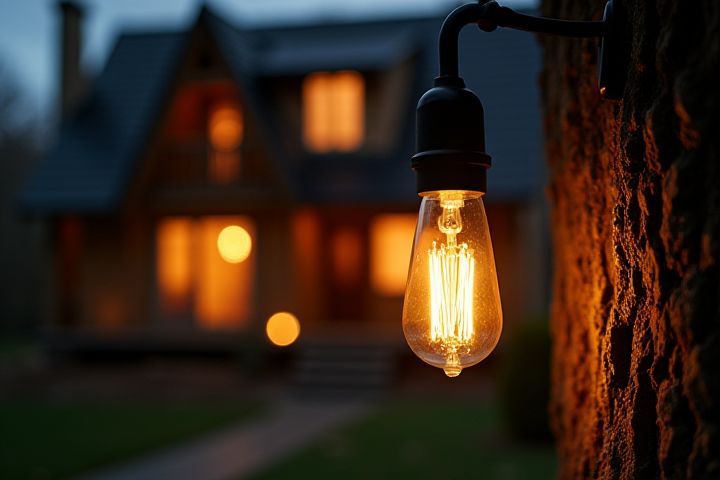
Proper lighting in your house involves a combination of ambient, task, and accent lighting to create a balanced and functional environment. Start with ambient lighting, which serves as the primary source of illumination; consider ceiling fixtures, recessed lighting, or floor lamps to enhance the overall brightness. For task lighting, focus on specific areas like your kitchen countertops or reading nooks; desk lamps or under-cabinet lighting are ideal for these purposes. Accent lighting can highlight artwork or architectural features; use track lighting or wall sconces to create an interesting focal point. Finally, incorporating dimmer switches will allow you to adjust the brightness to suit different moods and activities, enhancing your home's ambiance.
How To Light A House Properly
Layered lighting
Layered lighting involves combining three main types of illumination: ambient, task, and accent lighting. Ambient lighting provides the overall illumination for a room, typically through ceiling fixtures or wall sconces, ensuring the space feels welcoming and safe. Task lighting is designed for specific activities, such as reading or cooking, and includes table lamps, under-cabinet lights, or pendant fixtures that focus on work areas. Accent lighting highlights architectural features, artwork, or decorative elements, using spotlights or wall-mounted fixtures to create visual interest and depth in your home's design.
Task lighting
Task lighting is essential for creating functional spaces in your home, offering focused illumination for specific activities like reading or cooking. Consider using LED desk lamps with adjustable brightness levels for optimal light near work areas, ensuring a minimum of 400 lumens for effective visibility. Under-cabinet lights in the kitchen can provide direct light over countertops, enhancing safety and efficiency while preparing meals. Select fixtures with a color temperature of around 3000K to 4000K for a warm yet clear light that reduces eye strain during tasks.
Ambient lighting
Ambient lighting is essential for creating a warm and inviting atmosphere in your home. You can achieve this by utilizing various light sources, such as ceiling fixtures, wall sconces, or floor lamps, ideally offering a soft, diffused glow. Aim for a total wattage of around 100-150 watts per room, adjusting based on your space's size and style. Consider using dimmable fixtures to allow for flexibility in lighting levels, making it easier for you to tailor the brightness to your desired mood.
Accent lighting
Accent lighting enhances the architectural features and decor of your home, creating a warm and inviting atmosphere. To effectively implement accent lighting, consider using adjustable spotlights or track lighting to highlight artwork and architectural elements such as arches or textured walls. Positioning wall sconces or floor lamps strategically can provide depth and dimension in spaces like living rooms or hallways. Remember, the right intensity and color temperature not only elevate the visual appeal but also enhance the overall ambiance, making your spaces feel more personalized and welcoming.
Color temperature
Color temperature plays a crucial role in setting the mood and functionality of your home's lighting. Measured in Kelvin (K), a range of 2700K to 3000K provides a warm, inviting atmosphere, ideal for living areas and bedrooms. For task-oriented spaces like kitchens and work areas, opt for cooler tones between 3500K and 4100K to enhance visibility and concentration. Incorporating LED bulbs can offer energy efficiency, longevity, and a variety of color temperatures to personalize the lighting to your preferences.
Dimmable switches
Dimmable switches allow you to customize the brightness of your interior lighting, enhancing ambiance and energy efficiency by up to 20%. By installing dimmable switches in key areas such as living rooms and bedrooms, you create versatile environments--bright for activities or soft for relaxation. Consider using LED bulbs with a compatible dimmable switch, as they can last up to 25,000 hours, significantly reducing replacement frequency. To maximize your lighting setup, explore options like three-way dimmer switches that offer control from multiple locations, providing convenience in larger spaces.
Lighting controls
Effective lighting controls enhance both energy efficiency and user experience in your home. By integrating smart dimmers, timers, and occupancy sensors, you can adjust brightness levels to match your activities, reducing energy consumption by up to 30%. Utilizing smart home systems further allows you to schedule lights, ensuring they function only when needed, such as during daytime hours or when you're away. Consider implementing layered lighting with control systems in each zone of your home to create the ideal ambiance for various tasks and occasions.
Natural light integration
Incorporating natural light into your home can significantly enhance its ambiance and energy efficiency. Strategically placed windows, skylights, and glass doors can increase daylight exposure by up to 50%, reducing reliance on artificial lighting. Consider using reflective surfaces, like mirrors and light-colored walls, to amplify the light and distribute it evenly throughout your space. Positioning your work areas near windows not only boosts productivity but also improves overall well-being by connecting you with the outdoors.
Fixture placement
Proper fixture placement significantly enhances the ambiance and functionality of your house. Aim for a balance between ambient, task, and accent lighting by strategically positioning fixtures; for instance, place ceiling-mounted fixtures at a height of 7 to 8 feet for general illumination in living areas. In kitchens, install under-cabinet lighting 18 inches above the countertop to provide optimal work conditions, ensuring shadows are minimized. For accent lighting, position wall sconces 5 to 6 feet off the ground to highlight art or architectural features, creating a visually appealing focal point in your space.
Light pollution management
To effectively manage light pollution while lighting your house, prioritize using outdoor lighting fixtures that are dark-sky compliant. Opt for LED bulbs with a color temperature of 3000K or lower, which emit a warm light reducing glare and skyglow. Aim to position lights at a height of 10 to 12 feet to minimize light trespass into neighboring properties and direct illumination downward, illuminating only necessary areas like pathways and entrances. Incorporating timers or motion sensors can help ensure that lights operate only when needed, further reducing energy consumption and mitigating your home's impact on the surrounding environment.
